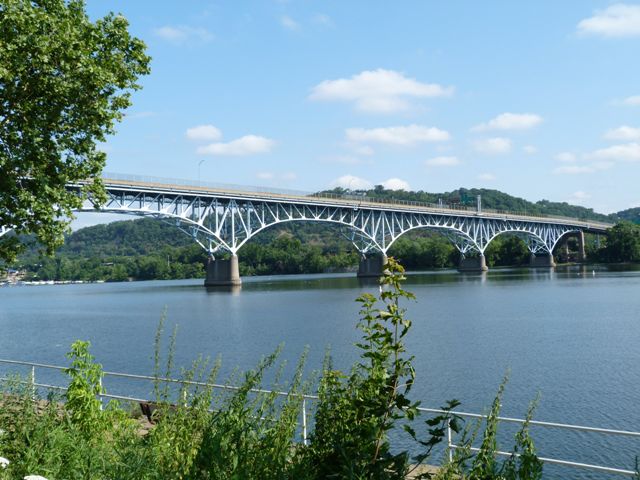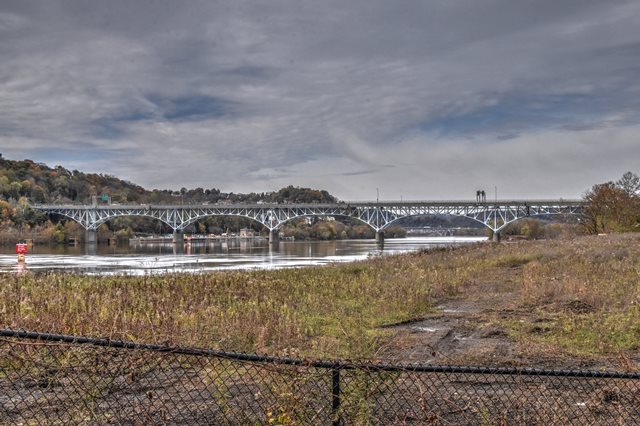We Recommend:
Bach Steel - Experts at historic truss bridge restoration.
BridgeHunter.com Phase 1 is released to the public! - Visit Now
Highland Park Bridge

Primary Photographer(s): Nathan Holth and Rick McOmber
Bridge Documented: July 17, 2011 and November 4, 2019
PA-1005 Over Allegheny River, PA-8, Railroad (Norfolk Southern)
Pittsburgh: Allegheny County, Pennsylvania: United States
Metal Cantilever 12 Panel Rivet-Connected Pratt Deck Truss, Fixed and Approach Spans: Metal Deck Girder, Fixed
1940 By Builder/Contractor: Bethlehem Steel Company of Bethlehem, Pennsylvania and Engineer/Design: Allegheny County Department of Public Works
1988
278.0 Feet (84.7 Meters)
2,423.0 Feet (738.5 Meters)
56 Feet (17.07 Meters)
7 Main Span(s) and 9 Approach Span(s)
2100500200000

View Information About HSR Ratings
Bridge Documentation
View Archived National Bridge Inventory Report - Has Additional Details and Evaluation
View Historical Article About This Bridge
This is an extremely unusual cantilever bridge because it is composed of many cantilever spans, with each span being very short for the cantilever type of bridge. In this manner, the bridge is similar to the Inner Belt Bridge in Cleveland. Although each main span looks the same in general, each span alternates between a pair of two anchor arms on one span to two cantilever arms and a suspended span on the next span. The suspended span sections can be identified by pin connections or hinges that occur at each end of the suspended span. The center truss span has a suspended span, as do two additional main spans.
The original railings on this bridge have been replaced with New Jersey barriers.
This bridge is noteworthy as a major bridge built with the assistance of Depression-era federal relief funds.
Information and Findings From Pennsylvania's Historic Bridge InventoryDiscussion of Bridge The 16 span, 2,421' long, bridge has 5, 278'-long Pratt deck truss river spans. The outermost and middle river spans have suspended sections with pinned connections to facilitate construction. The 2 deck truss cantilevered end spans are about 164' long. There are 6 deck girder approach spans on the north side and 3 stringer approach spans on the south side. The trusses are composed of built up members, and the bridge has no innovative or distinctive details. The brackets for the cantilevered deck sections and safety shape barriers were placed in 1986. The bridge utilizes engineering principles known and used through the first four decades of the 20th century. The span lengths are short for the continuous-cantilever bridge type. Although large, the bridge is not historically or technologically significant. It was started in 1937 by the county but not completed until 1940. Discussion of Surrounding Area The Highland Park bridge carries a 4 lane road over the Allegheny River, Conrail tracks on each side of the river, and local streets. The bridge connects with major highways on both sides of the river and is not related to or was part of the development of Highland Park. It is not part of any potential historic district. Bridge Considered Historic By Survey: No |
This bridge is tagged with the following special condition(s): Unorganized Photos
![]()
Photo Galleries and Videos: Highland Park Bridge
Bridge Photo-Documentation
Original / Full Size PhotosA collection of overview and detail photos. This gallery offers photos in the highest available resolution and file size in a touch-friendly popup viewer.
Alternatively, Browse Without Using Viewer
![]()
Bridge Photo-Documentation
Mobile Optimized PhotosA collection of overview and detail photos. This gallery features data-friendly, fast-loading photos in a touch-friendly popup viewer.
Alternatively, Browse Without Using Viewer
![]()
2019 Additional Unorganized Photos
Original / Full Size PhotosA supplemental collection of photos that are from additional visit(s) to the bridge and have not been organized or captioned. This gallery offers photos in the highest available resolution and file size in a touch-friendly popup viewer.
Alternatively, Browse Without Using Viewer
![]()
2019 Additional Unorganized Photos
Mobile Optimized PhotosA supplemental collection of photos that are from additional visit(s) to the bridge and have not been organized or captioned. This gallery features data-friendly, fast-loading photos in a touch-friendly popup viewer.
Alternatively, Browse Without Using Viewer
![]()
Maps and Links: Highland Park Bridge
Coordinates (Latitude, Longitude):
Search For Additional Bridge Listings:
Bridgehunter.com: View listed bridges within 0.5 miles (0.8 kilometers) of this bridge.
Bridgehunter.com: View listed bridges within 10 miles (16 kilometers) of this bridge.
Additional Maps:
Google Streetview (If Available)
GeoHack (Additional Links and Coordinates)
Apple Maps (Via DuckDuckGo Search)
Apple Maps (Apple devices only)
Android: Open Location In Your Map or GPS App
Flickr Gallery (Find Nearby Photos)
Wikimedia Commons (Find Nearby Photos)
Directions Via Sygic For Android
Directions Via Sygic For iOS and Android Dolphin Browser
USGS National Map (United States Only)
Historical USGS Topo Maps (United States Only)
Historic Aerials (United States Only)
CalTopo Maps (United States Only)


